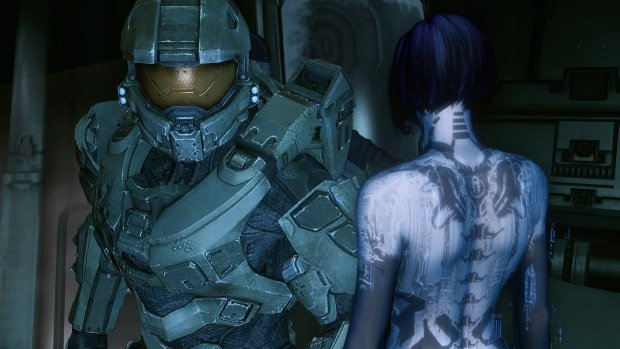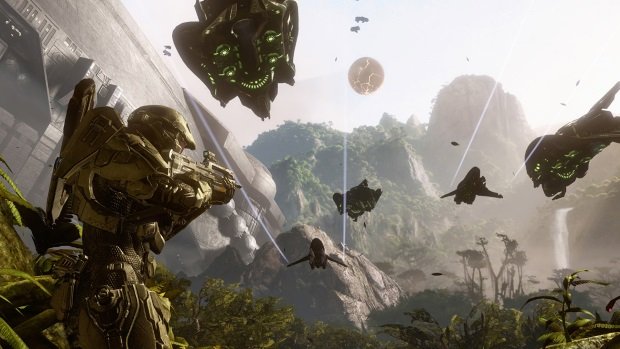Video games have their share of long and storied franchises. But around the seventh or eighth sequel, it can be difficult for newcomers to know where to start. These guides will point you in the right direction, and who knows? Maybe you'll find a new favorite!
The Halo series is overflowing with jargon and sci-fi colloquialisms that could confuse even the most seasoned of gamers. With seven entries in the main series, plus an RTS spin-off and two mobile games, it can be a daunting franchise to jump into. So whether you've never played a Halo game or just want to brush up on the difference between Prometheans and Precursors, we're here to help. So where should you start?
Halo 4. Let me tell you why:

The fight has been finished. Much hubbub was made of Master Chief (that'd be the big guy in green armor on almost every Halo game's cover) finishing the fight against The Covenant, an alien horde hell-bent on destroying humanity. That war was the focus of Halo 1 through Halo 3, as well as the prequel, Halo: Reach, and the RTS spin-off, Halo Wars. It's also over now. While a faction called the Covenant Remnant still operates in the depths of space, the major conflict is done with by the time Halo 4 starts. It's kind of like how The Force Awakens still has Empire-like bad guys, even though the Rebels blew up the Death Star and killed The Emperor in Return of the Jedi.
It's the game where you'll feel most connected to Chief. Chief isn't a completely silent protagonist, but he isn't known for being super talkative either. That's changed in Halo 4. At the beginning of this game, he's just woken up from cryosleep after drifting through space for four and a half years, meaning that he - just like you - has some questions. What's that weird structure up ahead? Who's on the comms? You and Chief are likely to want to know the same things, and the fact that Chief finally expresses some emotions makes it feel like you're starting this journey together.

It's 343 Industries' first real Halo game. Okay, so technically speaking Halo 4 is not the first Halo game from current series developer 343 Industries - that honor belongs to Halo: Anniversary, a reworking of the original Halo: Combat Evolved. Halo 4 is, however, the studio's first original title, meaning it's the first in the series where you might sense a different creative vision driving its designs. It's partly because of this change of hands that Chief feels like a different person in Halo 4 compared to his earlier appearances, and why his relationship with sidekick Cortana is more profound.
It'll test your skills in a way only Halo does. The Halo series is known for many things, but three stand out: a variety of enemies with reactive AI, a mix of on-foot and vehicular battles, and a sandbox-like structure to its level design. Halo 4 not only features all of these attributes, but expands on them. A new type of enemy presents fresh tactical challenges, the Mantis vehicle is a blast, and not only do many areas offer multiple routes of attack, but the "oh crap, I'm out of bullets for this gun, I'll just have to make do with whatever my enemies drop" mentality present since the first Halo is intact. You could argue whether or not Halo 4's multiplayer lives up to the series' legacy, but the campaign only adds to what makes a Halo game feel like Halo.
Sign up to the GamesRadar+ Newsletter
Weekly digests, tales from the communities you love, and more

So you've decided to take my advice and check out Halo 4. What's next? Well, if you find yourself immediately enamored with this universe and its denizens, your next purchase might not be a game at all; the Halo fiction spans comics, short stories, novels, movies, animated shorts, and even a podcast.
If you want the most background on The Forerunners and the prophecy of The Reclaimer (which is what Halo 4 and 343's story largely revolves around), I highly suggest The Forerunner Saga of novels by Greg Bear, starting with Cryptum. If you want to learn more about the enigmatic man known as Master Chief, check out The Fall of Reach by Eric Nylund. But if you're also aching to put your finger to the trigger and your thumbs on the buttons, there are plenty more quality Halo games to enjoy.
What to play next: Halo: Reach or Halo: Combat Evolved. The former will feel the most similar to Halo 4 in terms of raw mechanics, and its campaign is absolutely stellar from start to finish. Just one downside: you won't learn much of Master Chief, Cortana, or other major players in 343's version of Halo, since this is a prequel to the original Halo from 2001. If you think you can handle the jolt of jumping back 14 years in both graphics and controls, there's still nothing quite like Halo: Combat Evolved. And thankfully, there's plenty of ways to play it. Whether you've got an original copy running on the first Xbox, Halo: Anniversary on Xbox 360 or as part of the Master Chief Collection for Xbox One, this is the beginning of beginnings, and is not to be missed.
What to skip: Halo Wars, Spartan Strike, and Spartan Assault. Halo Wars actually tells a pretty cool story and shows how brutal the Human-Covenant War could be, but it's also an RTS designed for console, which makes it not terribly fun to play. Spartan Strike and Spartan Assault, however, are completely inconsequential. Fine enough to play if you need to kill time waiting at the bus stop, but not something you should go out of your way to experience.
Sam is a former News Editor here at GamesRadar. His expert words have appeared on many of the web's well-known gaming sites, including Joystiq, Penny Arcade, Destructoid, and G4 Media, among others. Sam has a serious soft spot for MOBAs, MMOs, and emo music. Forever a farm boy, forever a '90s kid.



